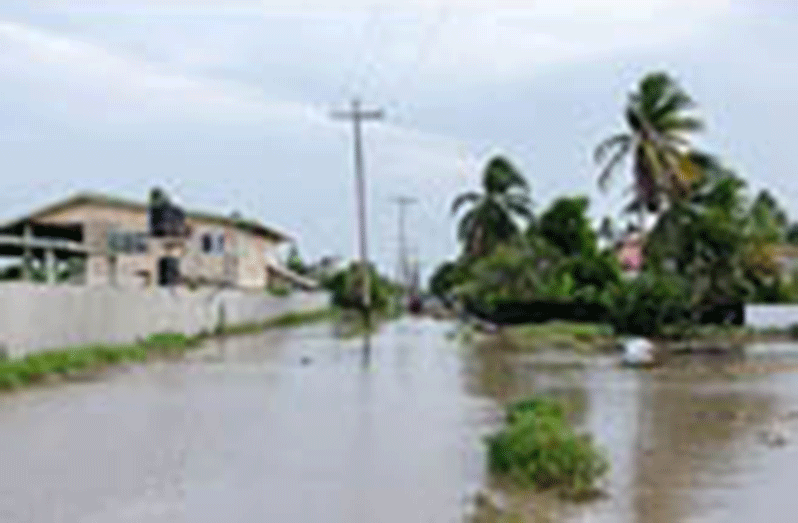I LIVE in a two-storey building on the uppermost flat. On rainy days, the potholes in my street, naturally, become filled with water. Many of my neighbours have built their yards so that the water can easily run off into the drains which are, thankfully, always clear. The closest natural body of water is the Atlantic Ocean, which lies beyond the seawall.
All of these factors mean that I am spared the direct impact of flooding, at least where I live. Over the past few weeks, however, as this intense rainy season got underway, I have been able to travel to a few communities around Guyana where several factors have contributed to flooding.
Permit me to first provide some simple context. Guyana, a low-lying country, is susceptible to flooding. We have been susceptible, perhaps since time immemorial, due to our geographic location at the north of the South American continent.
Within the borders of Guyana, many people have resided close to inland bodies of water (the river and canals), since this helps to sustain farming and livelihood activities. Living close to these bodies of water, however, means that increases in the water levels will result in flooding of homes and farmlands.
But the causative factors of flooding, from what I have seen, are nuanced. There is, of course, less-than-optimal management of drainage and irrigation infrastructure, but there is certainly also the occupation of low-lying areas and areas close to bodies of water; sea defence, and of course, the overarching yet not fully ventilated issue of climate change.
Similarly, the impact of flooding is nuanced as well. There is the disruption of livelihoods and damage to property, caused by the ongoing flooding. There is also the skyrocketing of prices of agricultural produce such as meat and vegetables, owing to the basic economic principles of supply and demand, whereby the prices are driven up, considering that the floods have resulted in a lower supply of the products, assuming that demand for these goods has remained the same.
Beyond these more apparent and immediate effects of the flooding, there are some underlying considerations of environmental migration. According to the International Organization for Migration (IOM), there is no internationally accepted definition for persons who move (migrate) due to environmental drivers- such as natural disasters and extreme changes in the natural environment.
Still, the IOM, in 2007, developed a conceptual framework that stated: “Environmental migrants are persons or groups of persons who, predominantly for reasons of sudden or progressive change in the environment that adversely affects their lives or living conditions, are obliged to leave their habitual homes, or choose to do so, either temporarily or permanently, and who move either within their country or abroad.”
 Considering this definition, I think about the people in Kwakwani, Region 10 (Upper Demerara-Upper Berbice), for example. The photos of the flooding in Kwakwani have been among the more striking ones that I have seen during this rainy season, with the water level above houses and buildings.
Considering this definition, I think about the people in Kwakwani, Region 10 (Upper Demerara-Upper Berbice), for example. The photos of the flooding in Kwakwani have been among the more striking ones that I have seen during this rainy season, with the water level above houses and buildings.
Due to this level of water, some of the residents have, reportedly, been forced to take up residence in shelters set up by the Civil Defence Commission (CDC) in other areas of the community. These residents who were forced to move lived either on the riverbank of the Berbice River or very close to the river bank. As such, when the water level rose exponentially due to high tides and heavy rainfall, their houses became inundated and uninhabitable.
In other communities across Guyana, there are similar occurrences. Several shelters have been set up by the CDC and the regional authorities while in some cases, residents have opted to take shelter with their families and close friends.
Much like those people who live in sister Caribbean countries who have to move when their homes are ravaged by hurricanes, so too do Guyanese have to undergo this uncomfortable movement of leaving one’s home behind- even if temporarily.
Considering the causative factors of the flooding and its impact, it is left to be seen what medium to long-term measures will be instituted to mitigate future occurrences of this disaster. These measures, I understand, will be discussed further once the immediate threat has receded and the process of rebuilding begins.
Still, there are considerations we can all begin thinking about from now. In a previous column, I wrote about how Guyana’s expected infrastructural development ought to consider adequate drainage and irrigation capabilities. Now, I am trying to add another layer to the conversation of flood mitigation- the vulnerability of people living in areas that may be more susceptible to flooding and the layered issues that arise out of this vulnerability.
If you would like to connect with me to discuss this column or any of my previous works, feel free to email me at vish14ragobeer@gmail.com



.jpg)










